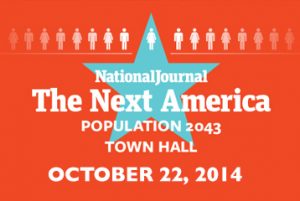National Journal Holds Town Hall on Changing Demographics
 The National Journal, a DC-based magazine covering policy and politics in Washington and beyond, is doing a series called The Next America: Population 2043, about issues relating to the nation’s changing demographics. Des Moines is “ground zero” for part of the series, looking at how the population is changing in our community and what it means, including for education and our schools.
The National Journal, a DC-based magazine covering policy and politics in Washington and beyond, is doing a series called The Next America: Population 2043, about issues relating to the nation’s changing demographics. Des Moines is “ground zero” for part of the series, looking at how the population is changing in our community and what it means, including for education and our schools.
As a part of this series, the National Journal is holding a Town Hall meeting in Des Moines on October 22. Des Moines Public Schools and United Way of Central Iowa are serving as community supporters of this event.
You are invited to attend this special event, which will be:
Wednesday, October 22, 2014
- Registration: 9:00 am
- Program: 9:30 – 11:30 am
Drake University
- Olmsted Center – Parents Hall South
- 2875 University Avenue
Click here to RSVP for the event in advance.
Click here to download a brochure about the event.
The event will feature remarks by The Honorable Catherine Lhamon, Assistant Secretary for Civil Rights at the U.S. Department of Education, as well as panel discussions by education, immigration and demographic experts, including several representatives from Des Moines Public Schools.
And be sure to read the National Journal’s story “Why Des Moines Can Be A Model for Urban Schools,” on why greater diversity or poverty doesn’t have to be a barrier to increasing student achievement or raising the graduation rate. As the article notes about DMPS: “A majority of students are minorities. Poverty rates are going up. Refugees speak 100 different languages and dialects. And despite all this, the school district is seeing gains.”
Below is the National Journal’s announcement about The Next America: Population 2043 town hall meeting.
America today is experiencing one of the largest demographic shifts in the country’s history. U.S. minorities represent nearly 40 percent of the overall population and almost half of the nation’s under-18 population; the result of a historic wave of immigration that began in 1965. Consequently, the U.S. Department of Education recently projected that students of color will comprise a majority of the country’s public school K-12 students this coming school year. The U.S.’ deepening diversity has huge implications for the country’s education system and workforce and is revolutionizing the national agenda.
Des Moines, Iowa is one of the many U.S. communities experiencing unprecedented diversification, especially among its younger populations. The city’s Hispanics outnumber the African-Americans living there, White Americans now comprise only 70 percent of Des Moines’ population, and 53 percent of the city’s public K-12 students are children of color. Notably, Des Moines’ public school enrollment, graduation, and student achievement rates have all risen in recent years—a testament to the county’s growing diversity, school officials say. The city’s demographic shifts demonstrate how even heartland communities long thought of as homogenous are being transformed by diversity. This is creating opportunities and challenges for Des Moines’ schools as they grapple with the change that immigrants and other new arrivals bring to the region.
What factors have driven Des Moines’ racial and ethnic population change? How do Des Moines’ schools best provide for all of the city’s students—including foreign-born children and those of color? What effect is the city’s immigrant-driven demographic change having on Des Moines’ pusblic school system and workforce? And what lessons can be learned from recent demographic developments in Des Moines? National Journal proposes a policy summit in Des Moines, Iowa to convene the region’s key opinion leaders for a robust discussion about the region’s propulsive diversification and its implications for the “Hawkeye State.”




